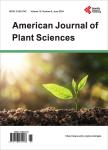Anatomical Studies on Compatibility and Incompatibility of Some Solanaceous Plant Species to Field Dodder (<i>Cuscuta campestris</i>Yuncker)
Anatomical Studies on Compatibility and Incompatibility of Some Solanaceous Plant Species to Field Dodder (<i>Cuscuta campestris</i>Yuncker)作者机构:Department of Biology Faculty of Education University of Sirt Sirt Libya Department of Science Faculty of Education University of Holy Quraan Omdurman Sudan
出 版 物:《American Journal of Plant Sciences》 (美国植物学期刊(英文))
年 卷 期:2014年第5卷第15期
页 面:2426-2430页
学科分类:1002[医学-临床医学] 100214[医学-肿瘤学] 10[医学]
主 题:Compatible or Incompatible Hosts Field Dodder Haustorium Searching Hyphae Solanaceous Plant Species
摘 要:Four solanaceous plant species, namely hot pepper (Capsicum frutescensL.), potato (Solanum tuberosumL.), tobacco (Nicotiana tabacumL.) and tomato (Lycopersicon esculentumMiller) were anatomically screened for compatibility/incompatibility to field dodder (Cuscuta campestrisYuncker, Cuscutaceae). The development of field dodder haustorium within stem tissues of the studied solanaceous plants was found to depend on the latter’s response to the former’s penetration. In hot pepper and tobacco, which showed a positive response, the haustorium was well developed and its searching hyphae established connections with their vascular tissues. However, potato and tomato showed a negative response and acquired different defense mechanisms against the parasitism of field dodder. In both of them, the field dodder haustorium and/or its searching hyphae exhibited distorted appearance and failed to establish connection with their vascular tissues. Thus, the tested solanaceous plant species could be classified as either compatible (hot pepper and tobacco) or incompatible (potato and tomato) hosts to field dodder.



